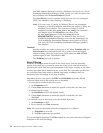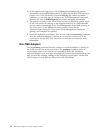-date1 $1
-date2 $2
date PRINTF("%s %s", date1, date2)
END
FORMAT NT_Share_Dir_Missing FOLLOWS NT_Base
%t %s %s %s %s %s %s The server service was unable to recreate
the share %s because the directory %s no longer exists.
sharename $8
directoryname $9
END
FORMAT NT_Service_Start FOLLOWS NT_Base
%t %s %s %s %s %s %s %s* started successfully.
service $8
END
FORMAT NT_Service_Started FOLLOWS NT_Base
%t %s %s %s %s %s %s The %s* service was started.
service $8
END
Class Definition Statement File
CDS files are used by an adapter to map incoming raw events to a particular class
and to define event attributes before forwarding the event to the event server.
No alterations to this file are necessary to use an adapter unless you alter the
corresponding .fmt file (if any). If any event definition is changed in a CDS file,
the corresponding event class definition in the BAROC file might need changing as
well. Event definition content and syntax are discussed in the IBM Tivoli Enterprise
Console Rule Builder’s Guide.
See Appendix C, “Class Definition Statement File Reference” on page 155 for details
about CDS files.
Example
The following example shows a CDS file:
#
# Default attribute values
#
MAP_DEFAULT
source = SNMP;
sub_source = NET;
# forwarding_agent = $SOURCE_ADDR;
origin = $AGENT_ADDR;
adapter_host = $ADAPTER_HOST;
END
CLASS Authentication_Failure_Cisco
SELECT
1: ATTR(=,$ENTERPRISE), VALUE(PREFIX, "1.3.6.1.4.1.9");
2: $TYPE = 4;
3: ATTR(=,"authAddr");
FETCH
1: IPNAME($SOURCE_ADDR);
MAP
hostname = $F1;
originating_address = $V3;
END
# For Cisco routers, because we know the interface generating the trap,
# we map ’linkUp’ traps to ’linkDown’ CLOSED events
CLASS Link_Down_Cisco
SELECT
1: ATTR(=,$ENTERPRISE), VALUE(PREFIX, "1.3.6.1.4.1.9");
2: $TYPE = 3;
3: ATTR(=,"ifIndex");
18 IBM Tivoli Enterprise Console: Adapters Guide


















